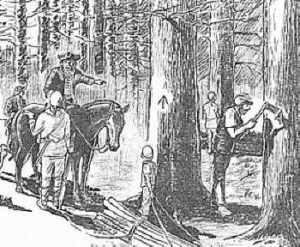The Story of the Pine Tree RiotThose Trees are for the King - The Real Start of the RevolutionBy Brent Smith February 24, 2020 Practically everyone knows of the “Boston Tea Party” that occurred in 1773. It is recognized as the action which began America’s revolution. Practically everyone knows of the “Boston Tea Party” that occurred in 1773. It is recognized as the action which began America’s revolution. However, there was an event that predates it, although few have heard the tale. In 1634, when the first shipment of ship masts from Portsmouth, New Hampshire to England occurred, England had already suffered deforestation. In order to dominate the high seas, new sources of abundant timber for shipbuilding were needed. No ships, after all, could set sail without as many as twenty-three masts, yards, and spars varying in length and diameter from the bulky main mast to its subordinate parts. Although New Hampshire's white pine trees were not as hard as Europe's, their height and diameter were superior. They also weighed less and retained resin longer, giving the ships a sea life as long as two decades. When granting lands in America in 1690, England’s King William prohibited the cutting of white pine over two feet in diameter. In 1722, under the reign of George I, parliament passed a law that reduced the diameter to one foot, required a license to cut white pine, and established fines for infractions. This law was basically ignored until John Wentworth became governor in 1767. Appointed Surveyor of the King's Woods, he recognized the revenue potential and appointed deputies to carry out the law. He conducted his own inspections of mill yards in the Piscataquog valley by having a servant drive him around in his coach. Before settlers could clear the land or build cabins, barns, or meetinghouses, the king's sanction, a broad arrow mark, was required on trees reserved for the Royal Navy. The deputies charged the colonists a "good, round sum" to mark the trees and for the license required to cut the rest. Small wonder the law was unpopular. The consequences involved arrest and fines. Contraband white pine already sawed into logs could be seized and a large settlement required; if not paid, authorities sold them at public auction. In the winter of 1771-72, a deputy Surveyor of the King's Woods found and marked for seizure 270 mast-worthy logs at Clement's mill in Oil Mill (now called Riverdale), in South Weare, New Hampshire. He fined the log-cutters from Weare and those from nearby towns where illegal logs were also found. Men from other towns paid the fines, but those from Weare refused. Consequently, the Weare men were labeled "notorious offenders." The county sheriff, Benjamin Whiting, Esq., of Hollis, N.H., and his deputy, John Quigley, Esq., of Francestown, N.H. were charged with delivering warrants and making arrests in the king's name. On April 13, 1772, the sheriff and his deputy galloped into Weare and found "Major Offender" Ebenezer Mudgett, who promised to pay his fine the next day. The officials then retired to nearby Quimby's Inn for an overnight stay. News that they had come for Mudgett flew through town, and a plan was hatched. The following morning more than twenty men with blackened faces and switches in hand rushed into Whiting's room led by Mudgett:
As for Deputy Quigley, the Weare men wrested the floorboards from the room above his, and proceeded to beat him with long poles. With "jeers, jokes, and shouts ringing in their ears," the sheriff and deputy rode toward Goffstown and Mast Road (about a mile from my office, I might add), named for the logs that were moved overland to the sea and off to England for the king's ships. The Weare men were ultimately arraigned and paid a light fine, but their rebellion against the crown, which preceded the Boston Tea Party (1773) by 18 months, helped set the stage for the Revolution. And thus the event became known as the Pine Tree Riot, April 14, 1772.
| ||||
 Brent Smith, "The Common Constitutionalist," offers not just conservative commentary and analysis, but a blend of politics, history, arts, science, and humor. Whoever said conservatives aren’t funny? Yeah, I know…most people. Brent is a contributing writer for numerous online publications. When he is not burning the midnight oil writing his insightful commentaries, he is raising his two teenage sons to be patriots and Conservatives. Brent Smith, "The Common Constitutionalist," offers not just conservative commentary and analysis, but a blend of politics, history, arts, science, and humor. Whoever said conservatives aren’t funny? Yeah, I know…most people. Brent is a contributing writer for numerous online publications. When he is not burning the midnight oil writing his insightful commentaries, he is raising his two teenage sons to be patriots and Conservatives.Visit Brent Smith's website at www.commonconstitutionalist.com
|
